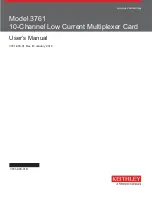
damage to the circuit of meter.
4.6 RESISTANCE measurement
4.6.1 Insert the black test lead into “COM” terminal and the red one into “VΩmA”
terminal;
4.6.2 Turn the rotary switch to “Ω
” ranges, press “SELECT/
” key to select “Ω”
mode. Connect two test leads across the resistor under test;
4.6.3 Auto range is the default when you turn on the meter, “AUTO” symbol displayed.
Press “RANGE/REL” key can change to Manual range, the available ranges are 600
Ω
, 6k
Ω
, 60k
Ω
, 600k
Ω
, 6M
Ω
, 60M
Ω
.
NOTE:
1) If you are not sure about the range of current under test, please select the highest
range;
2) If LCD displays “OL”, it means it is over range. Now you need to select a higher range.
When measuring value is over 1MΩ, the reading will take a few seconds to be stable.
It’s normal for high resistance measurement;
3) When input terminal is in open circuit, LCD will display “OL”;
4) Before measuring in line resistor, make sure that the power is off and all capacitors
are discharged completely;
5) When there is big error, it may be affected by other online component or there is
voltage on the resistor;
6) Do not input any voltage at resistance range.
4.7 CAPACITANCE MEASUREMENT
4.7.1 Insert the black lest lead in “COM” terminal and the red one in “V
Ω
mA” terminal;
4.7.2 Turn the rotary to switch to “
” range;
4.7.3 If the LCD doesn’t display “0”, press “RANGE/REL” to clear the reading;
4.7.4 Connect the capacitor to “COM” and “V
Ω
mA” terminal. (Note: the red test leads is
for positive pole +). LCD displays capacitance value.
NOTE:
1) Don’t input voltage or current under capacitance ranges;
2) Press “RANGE/REL” to clear the reading before testing to assure the accuracy;
3) There is only the auto range mode under the capacitance range;
4) The capacitor must be completely discharged before testing to avoid damage the
meter,;
5) The reading of a higher than 600uF range will take more several seconds to be
stabled.
4.8 FREQUENCY MEASUREMENT
4.8.1 Insert the lest leads or shielded cable into “COM” terminal and “V
Ω
mA” terminal;
4.8.2 Turn the rotary to switch to “Hz” range, connect the test leads or shielded cable to
the signal source or the load which is tested (It should over 3Hz).
4.8.3 Press “SELECT/
” key to choose frequency/duty cycle measurement, LCD will
display the frequency or duty cycle of the tested signal source.
NOTE:
1) There is only the auto range mode under the frequency range;
2) When the input is higher than 10V AC rms, please switch to
range and then
select frequency or duty cycle to measure;
3) In noisy environment, it's better to use shield cable to measure a low signal;
4) Do not touch the high voltage circuit when measuring high voltage circuit;
5) Don’t input voltage higher than 250V DC/AC peak value under Hz ranges, or it may
damage the meter.
4.9 NON‐CONTACT VOLTAGE (NCV) DETECT
WARNING:
This function could be affected by different external interference sources, and then the
alarm is activated by wrong signal. The measurement result is for reference only.
Turn the rotary function switch to “NCV” position. When the testing circuit is placed
above the meter, the meter displays the strength of signal, and the buzzer alarms with
“beep beep”.
NOTE:


























